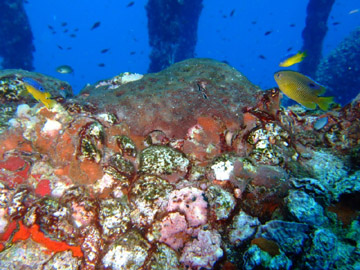 Many sea creatures make their homes on oil rigs. Credit: Brittanie Shey.
Many sea creatures make their homes on oil rigs. Credit: Brittanie Shey.Rich communities of sea life thrive on coral or rocky reefs in all the world’s oceans, but the Gulf of Mexico does not have many natural reefs. Its sea floor is mostly sandy and barren. But each of the more than 4,000 rigs in the Gulf offers two to three acres of complex habitats where animals can shelter from predators and ocean currents. This is good news for fishermen and divers, since there can be 20 to 50 times more fish at rigs.
According to law, owners of oil and gas platforms in the Gulf have one year to remove a rig once it is taken out of service. Removal is expensive, costing several million dollars, and it evicts the rig’s underwater residents. A Rigs-to-Reefs program turns this problem, quite literally, on its side. By moving and toppling rigs, retired platforms become permanent underwater habitats that attract fish, fishermen and divers.
It doesn’t take long for residents to move onto these new “reefs.” A few fish begin to gather within a week of a rig’s arrival, and by the end of a month, soft corals, mussels, barnacles, sponges, starfish and algae have moved to the neighborhood. Then come shrimp and other crustaceans, followed by gobies, red snapper, amberjack, red drum and triggerfish. Large pelagic fish, like tuna, mackerel and sharks, also take advantage of these ocean neighborhoods, for a quick meal or to rest.
Rig-reefs benefit everyone. Rig owners save millions in disposal costs, marine animals get a home and fishermen get a top-notch fishing spot — truly making rig-reefs neighborhoods for everyone.


